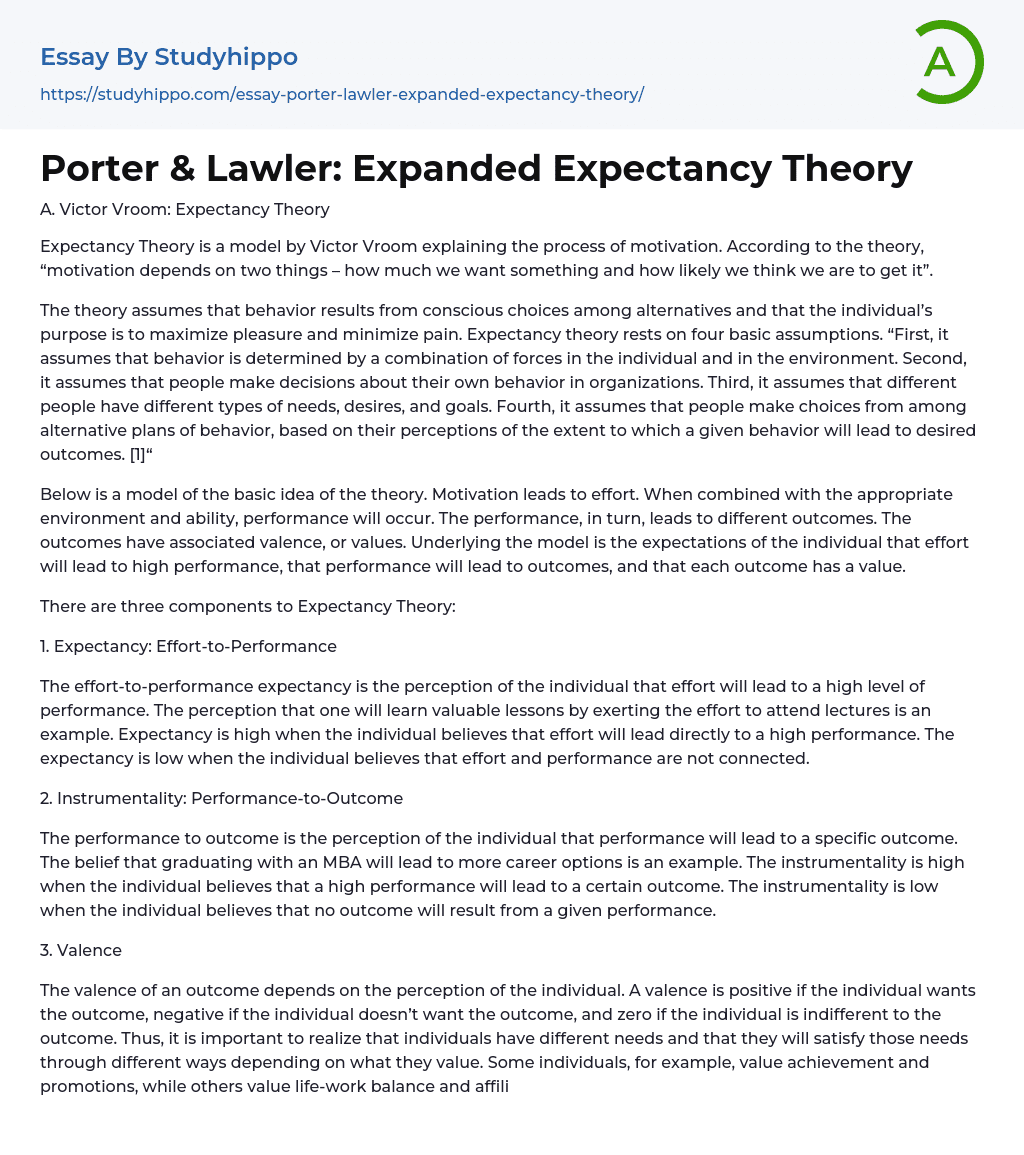

Porter & Lawler: Expanded Expectancy Theory Essay Example
A. Victor Vroom: Expectancy Theory
Expectancy Theory is a model by Victor Vroom explaining the process of motivation. According to the theory, “motivation depends on two things – how much we want something and how likely we think we are to get it”.
The theory assumes that behavior results from conscious choices among alternatives and that the individual’s purpose is to maximize pleasure and minimize pain. Expectancy theory rests on four basic assumptions. “First, it assumes that behavior is determined by a combination of forces in the individual and in the environment. Second, it assumes that people make decisions about their own behavior in organizations. Third, it assumes that different people have different types of needs, desires, and goals. Fourth, it assumes that people make choices from among alternative plans of behavior, based on their perceptions of the extent to which a give
...n behavior will lead to desired outcomes. [1]“
Below is a model of the basic idea of the theory. Motivation leads to effort. When combined with the appropriate environment and ability, performance will occur. The performance, in turn, leads to different outcomes. The outcomes have associated valence, or values. Underlying the model is the expectations of the individual that effort will lead to high performance, that performance will lead to outcomes, and that each outcome has a value.
There are three components to Expectancy Theory:
1. Expectancy: Effort-to-Performance
The effort-to-performance expectancy is the perception of the individual that effort will lead to a high level of performance. The perception that one will learn valuable lessons by exerting the effort to attend lectures is an example. Expectancy is high when the individual believes that effort will lead directly to a
high performance. The expectancy is low when the individual believes that effort and performance are not connected.
2. Instrumentality: Performance-to-Outcome
The performance to outcome is the perception of the individual that performance will lead to a specific outcome. The belief that graduating with an MBA will lead to more career options is an example. The instrumentality is high when the individual believes that a high performance will lead to a certain outcome. The instrumentality is low when the individual believes that no outcome will result from a given performance.
3. Valence
The valence of an outcome depends on the perception of the individual. A valence is positive if the individual wants the outcome, negative if the individual doesn’t want the outcome, and zero if the individual is indifferent to the outcome. Thus, it is important to realize that individuals have different needs and that they will satisfy those needs through different ways depending on what they value. Some individuals, for example, value achievement and promotions, while others value life-work balance and affiliation with co-workers.
In order for motivation to occur in an individual, which will lead to an exertion of effort, effort-to-performance expectancy must be greater than zero, performance-to-outcome expectancy must also be greater than zero, and the sum of the valences for the outcomes must be greater than zero (the outcome must have value to the individual).
In mathematical terms, motivation = expectancy x instrumentality x valence
Expectancy and Instrumentality are perceptions or attitudes. An individual’s perceived Expectancy is associated to beliefs regarding self-efficacy, goal difficulty, and control. To manage expectancy, managers are advised to set realistic goals and give employees a sense of control over their performance. Managers can coach
employees and give frequent feedback. Managers can also train and develop employee skills.
Instrumentality is associated with the individual’s perceived trust, control, and the policies in place. To increase instrumentality, managers are advised to establish a sense of trust with their employees, give employees a sense of control of the rewards, and have formal policies linking rewards to performance. Furthermore, rewards given should be deserved and desired by the employee.
The Porter-Lawler Extension of expectancy theory suggests that if performance results in equitable rewards, people will be more satisfied. Thus, performance can lead to satisfaction. Managers must, therefore, be sure that any system of motivation includes rewards that are fair, or equitable, for all. This theory was aptly summed up to this model below.
Actual performance in a job is primarily determined by the effort spent. But it is also affected by the person’s ability to do the job and also by individual’s perception of what the required task is. So performance is the responsible factor that leads to intrinsic as well as extrinsic rewards. These rewards, along with the equity of individual lead to satisfaction. Hence, satisfaction of the individual depends upon the fairness of the reward.
- Bias essays
- Big Five Personality Traits essays
- Body Image essays
- Mind essays
- Motivation essays
- Phobias essays
- Thought essays
- Code of Ethics essays
- Conflict essays
- Dress Code essays
- Human Resources essays
- Organizational Behavior essays
- Performance essays
- Recruitment essays
- Safety essays
- Abnormal Psychology essays
- Abraham Maslow essays
- Attachment Theory essays
- Authority essays
- Behaviorism essays
- Classical Conditioning essays
- Cognitive Psychology essays
- Counseling essays
- Developmental Psychology essays
- Educational Psychology essays
- Erik Erikson essays
- Family Therapy essays
- Jean Piaget essays
- Maslow's Hierarchy Of Needs essays
- Mental Health essays
- Operant Conditioning essays
- Personality Psychology essays
- Positive Psychology essays
- Psychoanalysis essays
- Psychotherapy essays
- Sigmund Freud essays
- Social Psychology essays
- Stanford Prison Experiment essays
- Supersize Me essays
- Experiment essays
- Explorer essays
- Hypothesis essays
- Observation essays
- Qualitative Research essays
- Research Methods essays
- Theory essays



